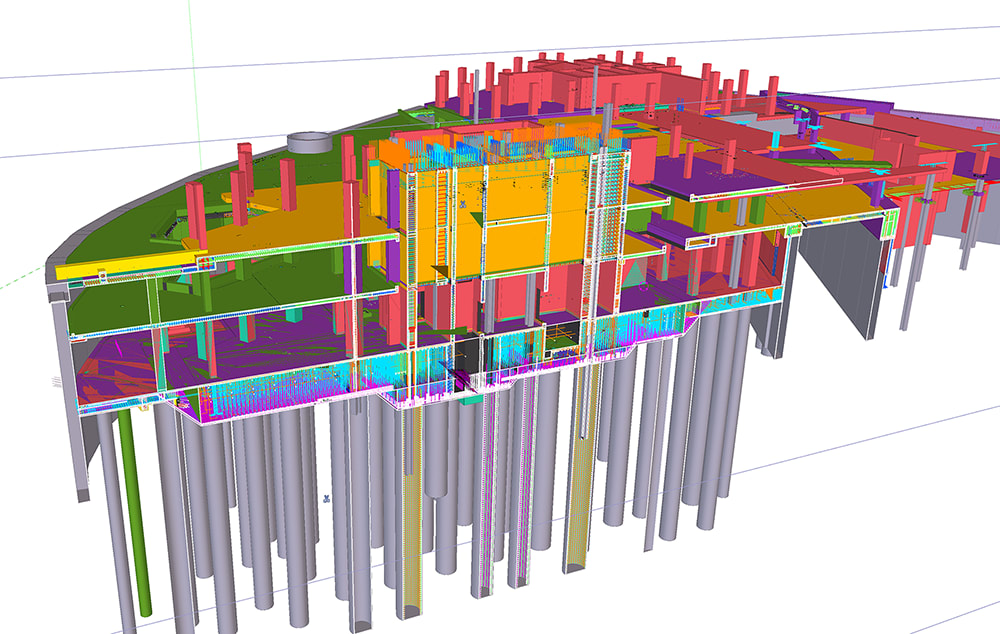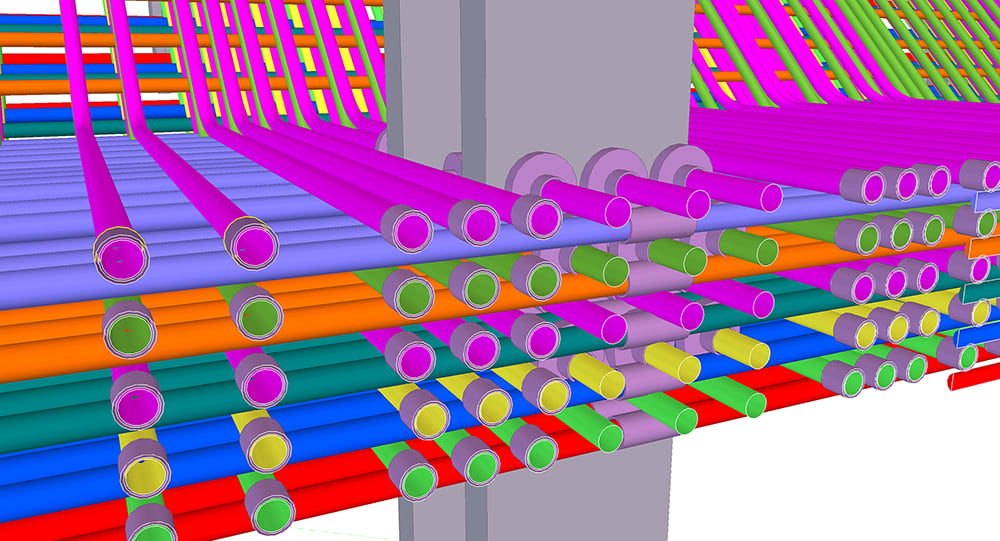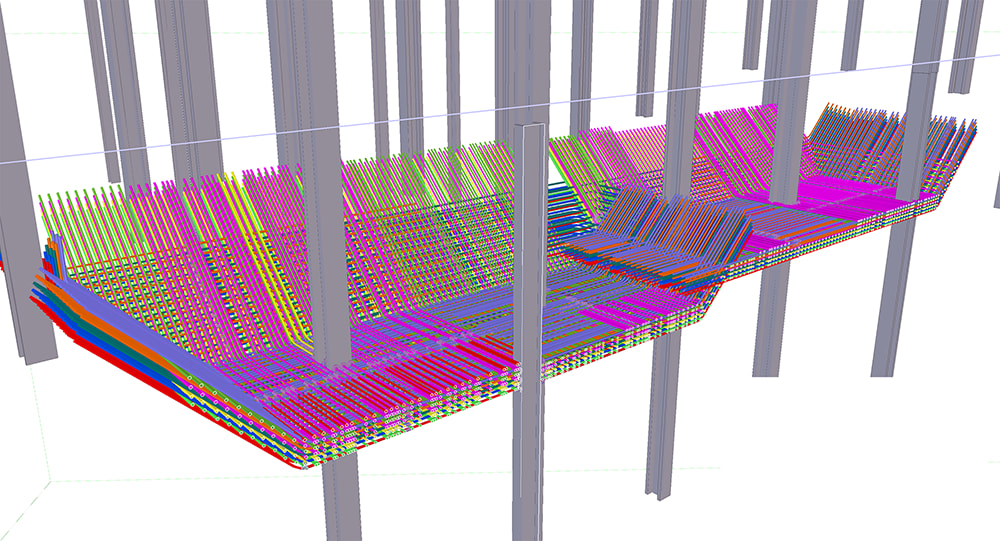- Client: Solve Structural Design (structural engineer)
- Lead Contractor: Careys Civil Engineering (concrete contractor)
- BIM Tools: Tekla Structures; Trimble Connect
With an estimated project value of £1bn, One Nine Elms, a prestigious high-rise mixed-use development on the south bank of London’s River Thames, forming part of the wider Nine Elms redevelopment, will provide the city with a mixture of luxury residential apartments, a 173-bedroom five-star hotel – with a spa, ballroom and clubhouse restaurant – and 1,000 sq ft of retail outlets.
Following a decision to construct the building’s three-story basement using the efficient top-down construction method, Careys Civil Engineering, the project’s concrete contractor, commissioned Solve Structural Design to complete the 3D RC detailing package of all reinforced concrete elements of the building’s substructure. Faced with this challenging task, Solve Structural Design turned to Tekla Structures’ BIM software for assistance.
Barry Peniston, Solve Structural’s technical director, explains: “The Tekla workflow was particularly valuable on the One Nine Elms project, especially considering the sheer amount of reinforced concrete required and the selected top-down construction method.”
Often favoured for its ability to reduce a project’s overall build time and the associated costs, constructing a building’s sub-levels from the ground floor downwards allows the work above-ground to be carried out consecutively, without either being disturbed by the other. However, while top-down construction has many benefits, it also understandably presents project teams with additional technical and logistical challenges.

The site was excavated down to the first tower sub-level, where the concrete floor was cast, along with the supporting columns and walls
Peniston adds: “One of the main challenges we encounter when working with a top-down method of construction is ensuring that a means of rebar continuity – mainly couplers and pullout bars – are provided in the slab soffit for all vertical elements, before moving down to the next sub-level. When RC drawings are completed in isolation or 2D, the chances of rebar being missed are greatly increased, which in turn can cause huge time delays, as well as additional costs for the required remedial works.
“Fortunately, 3D modelling, such as that provided within Tekla Structures, allows for the proposed drawings to be checked quickly and accurately, ensuring that full continuity has been provided before any concrete is cast.”
At One Nine Elms, Solve Structural Design was responsible for providing 3D rebar models in IFC format for all concrete elements, along with the traditional 2D drawings and bending schedules for placement and rebar procurement.
In terms of construction, the site was excavated down to the first tower sub-level, where the concrete floor was cast, along with the supporting columns and walls. Full storey “ring beams” were also constructed under the main cores, in order to provide support for the ground floor to be cast above and for the main superstructure to begin construction.
The earth below was then excavated down to the second sub-level, with access granted through “mole holes”. The heavily reinforced lower concrete raft was then also cast, followed by all remaining vertical walls and columns.

Tekla’s automatic clash detection allowed quick assessment of the design intent and spot any potential issues early on
“Considering the scale of the project, with over 5,000 tonnes of reinforcement in the basement structure, and the tight, limited means of access, it was imperative that everything was planned, detailed and coordinated to a high degree of accuracy,” says Penistion.
“Thanks to Tekla’s automatic clash detection, we were able to quickly assess the design intent and spot any potential issues very early on in the detailing process. Any problems or clashes were then able to be reviewed and resolved, before even the primary drawings had been issued; streamlining the whole detailing process, saving both ourselves and the other project parties valuable time in terms of approvals and reducing the amount of rebar cutting or changes that would normally be expected on a project of this size and complexity.
“We were also able to review other aspects of the model, including any buildability issues, site practicalities or restrictions and concrete pour sequences, all of which we would not normally have been able to consider in the traditional 2D detailing process.”
The benefits of working with Tekla were highlighted during the detailing of the City Tower concrete base raft, which was to measure 5.2 metres at its deepest point and contained around 1,400 tonnes of rebar.
Penistone explains: “During the modelling process of the core raft, it quickly became evident that there were some serious issues regarding heavy rebar congestion and clashes, particularly around the ‘plunge’ columns that formed the main sub-structural support and at the corners of the sloping sides. Fortunately, the preliminary 3D model highlighted these problems with the base raft’s buildability at an early stage and we were able to promptly host an online meeting with all project parties.
“The Tekla model formed the central focal point of discussions and allowed us to clearly demonstrate the clashes and other issues to the relevant design and site teams. Over the following weeks, various solutions and options were discussed and proposed and a final working model was agreed upon, which was proven to be buildable.”

The City Tower concrete base raft contained around 1,400 tonnes of rebar
While Tekla Structures was the predominant software employed by Solve Structural Design on the One Nine Elms project, Trimble Connect was also used. A cloud-based software, Trimble Connect helps to improve collaboration and communication within and between project teams, connecting everyone to the relevant data, wherever they are based.
“In addition to using Trimble Connect internally for all document administration and filing, task management and model checking, our One Nine Elms site team were also able to easily access it on their mobile phones and tablets,” says Penistone. “This allowed them to view the completed 3D model alongside the real-time physical context, assisting them in the placement and installation of the rebar and ensuring an efficient and accurate delivery on site.
“Due to the scale and complexity of the rebar, clearly displaying the amount of information required to assist with on-site installation in a traditional 2D format would have required a huge amount of sections and detail, which could have easily led to confusion.”
All of the sub-floor rebar components have now been installed and concrete cast, with the River Tower raft being the second longest continuous concrete pour in London’s history, at 4,852m3. Solve Structural Design’s contribution to the project has been recognised in the BIM industry, winning the Commercial Project category in the UK Tekla Awards 2019, where it was praised by judges for its “very impressive rebar model, with complex and detailed areas”.















